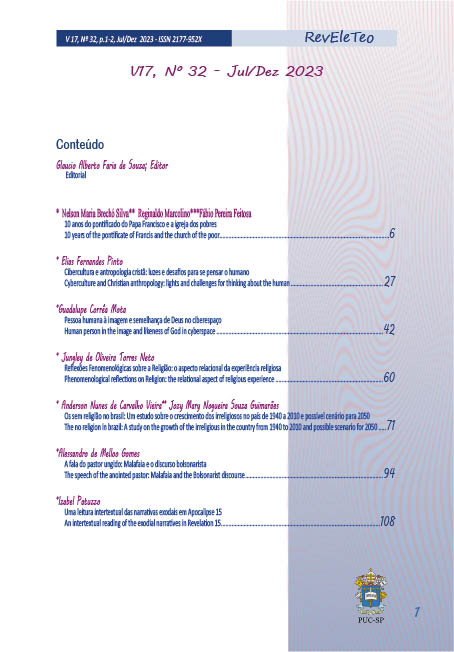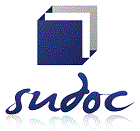Human person in the image and likeness of God in cyberspace
DOI:
https://doi.org/10.23925/2177-952X.2023v17i32p42-59Keywords:
Theological Anthropology, Three Persons of the Holy Trinity, Human Person, Digital CybercultureAbstract
In this second decade of the 21st century, we witness the emergence of new digital technologies, materialized on the internet, in digital social networks, in machines equipped with artificial intelligence, which are radically transforming the way we think, live and relate. For Christians, the advancement of these technologies generates deep reflections on the meaning of human existence, life, death, and, consequently, questions about the existence of God and the way we relate to the One we call God-Father Creator. , the Three Persons of the Holy Trinity. This article, in the form of a critical essay, based on references from Christian Anthropology and the Magisterium of Pope Francis, and in interdisciplinary dialogue with authors from the field of Communication and Digital Cyberculture, focuses on the discussion on the concept of “human person as face-to-face relationality” in light of ongoing social and technological transformations, based on the question: which image of God and which image of human beings are being created in this new configuration of human sociability? In conclusion, the inalienable dignity of the human person and his condition as a creature in the image and likeness of God, whose ultimate reference of humanity is Jesus Christ, is reaffirmed, in the face of techno-scientific and cultural pretensions to dispense with the human and transcendental relationality in the garden of new digital cyber life, and practical insights are pointed out for a qualified evangelizing action in the digital environment of cyberspace.
References
ARAÚJO, Manfredo. O novo humanismo segundo o Papa Francisco. In. MOL GUIMARÂES et al. O novo humanismo: paradigmas civilizatórios para o século XXI a partir do Papa Francisco. São Paulo: Paulus. 2022, p. 335-377.
CONCÍLIO VATICANO II. Constituição Dogmática Dei verbum sobre a revelação divina. In: Concílio Ecumênico Vaticano II - Documentos. Brasília: Edições CNBB, 2018.
CONCÍLIO VATICANO II. Constituição Dogmática Gaudium et spes sobre a igreja no mundo de hoje. In: Concílio Ecumênico Vaticano II - Documentos. Brasília: Edições CNBB, 2018.
DE MORI, Geraldo. O anúncio de Jesus Cristo em novos tempos. Nas fronteiras da “insignificância”, do sujeito vulnerável e da tecnociência. In. ALBUQUERQUE; GODOY (Orgs.). A pastoral numa igreja em saída. Brasília: CAPES. Belo Horizonte: FAJE. São Paulo: Loyola. 2018.
FELINTO, Erick; SANTAELLA, Lúcia. O explorador de abismos: Vilém Flusser e o pós-humanismo. São Paulo: Paulus, 2012. (Coleção Comunicação).
FRANCISCO, Papa. 2023. Mensagem para o Dia Mundial da Paz 2024. Inteligência artificial e paz. Disponível em: <https://www.vatican.va/content/francesco/pt/messages/peace/documents/20231208-messaggio-57giornatamondiale-pace2024.html>. Acesso em: 14 dez. 2023.
FRANCISCO, Papa. (EG) Exortação apostólica Evangelii gaudium. São Paulo: Paulus/Loyola. 2013.
FRANCISCO, Papa. (LS) Carta Encíclica Laudato Si – sobre o cuidado da casa comum. São Paulo: Paulus/Loyola. 2015.
GROSS, Fernando. A velhice e a ancianidade no Pentateuco. Tese (Doutorado). 120p. 2023 - Pontifícia Universidade Católica de São Paulo. Filosofia e Teologia. São Paulo: São Paulo. 2023.
IHU. A humanidade das máquinas. Da inteligência artificial à senciência artificial. Disponível em: <https://www.youtube.com/watch?v=RbG7u32r_zM>. Acesso em: 2 dez. 2023.
JORNAL DA USP. Cresce em mais de 140% o número de procedimentos estéticos em jovens. Tainá Lourenço. Atualidades. 12/06/2023. Disponível em: https://jornal.usp.br/atualidades/cresceu-mais-de-140-o-numero-de-procedimentos-esteticos-em-jovens-nos-ultimos-dez-anos/. Acesso em: 12 nov. 2022
LADARIA. Antropologia. In. LATOURELLE & FISICHELLA (org.). Dicionário de Teologia Fundamental. Tradução de Luiz João Baraúna. Petrópolis, Rio de Janeiro: Vozes, p. 68-72.
LIBANIO, J. B. Qual o futuro do cristianismo? São Paulo: Paulus, 2006. (Temas da Atualidade).
PALÁCIO, Carlos. A ORIGINALIDADE SINGULAR DO CRISTIANISMO. Perspectiva Teológica, [S. l.], v. 26, n. 70, p. 311, 1994. Disponível em: https://www.faje.edu.br/periodicos/index.php/perspectiva/article/view/1181. Acesso em: 12 dez. 2023.
SANTAELLA, Lúcia. Neo-humano, a sétima revolução cognitiva do sapiens. São Paulo: Paulus. 2022.
SANTAELLA, Lúcia. Humano hiper-híbridos: linguagens e cultura na segunda era da internet. São Paulo: Paulus. 2021.
SANTAELLA, Lúcia. Navegar no ciberespaço: o perfil cognitivo do leitor imersivo. 6 reimp. São Paulo: Paulus. 2018.
SANTAELLA, Lúcia. Comunicação ubíqua:repercussões na cultura e na educação. São Paulo: Paulus. 2013.





